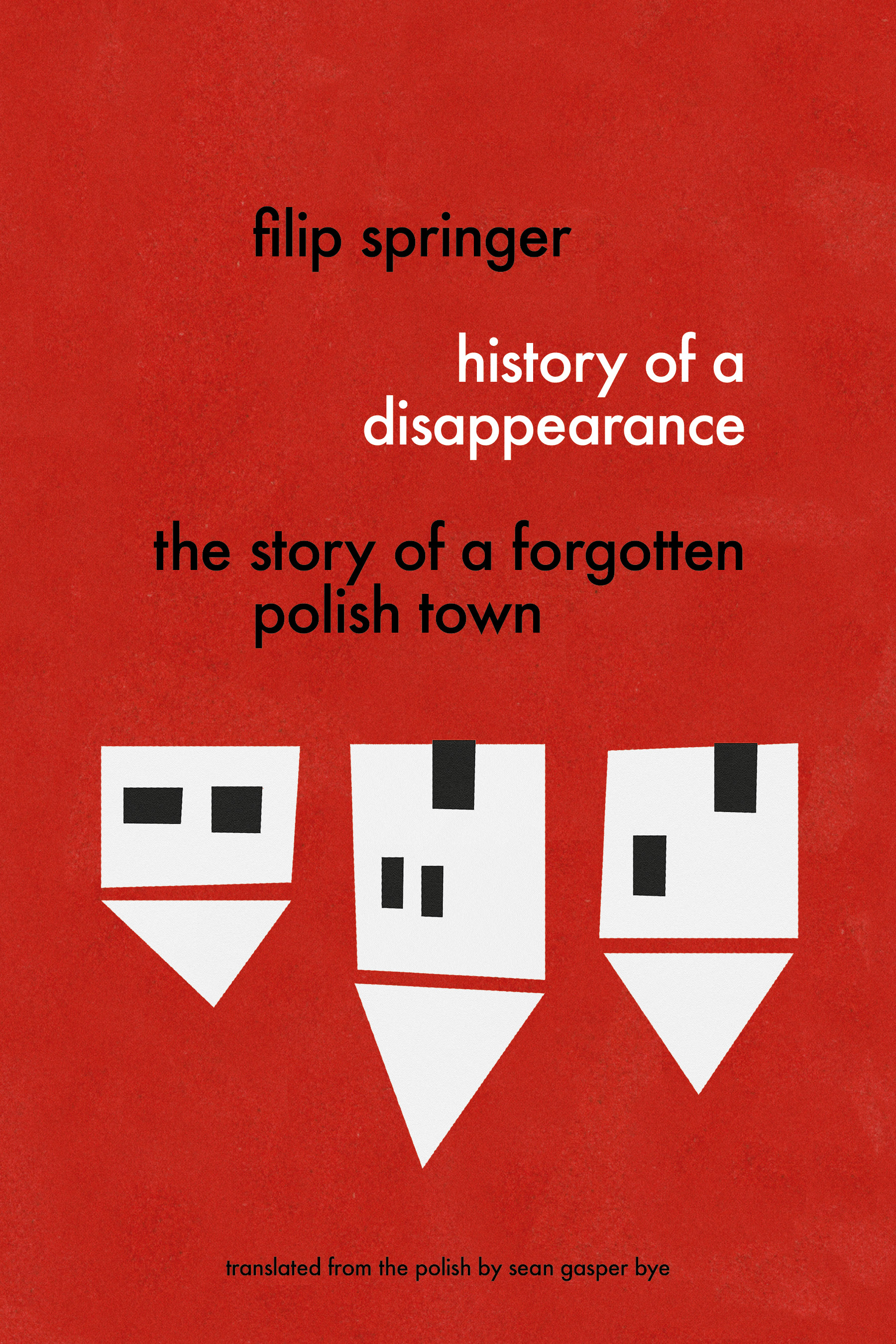
Translated by SEAN GASPER BYE
Decades of neglect and environmental degradation led to Miedzianka being declared uninhabitable, and the population was evacuated. At the center of the city, the church took the longest to disappear.
The church took longest to disappear. In the only surviving color photograph, you can see it had a yellow façade, tall stained-glass windows, and that it towered strikingly above the area. Large, wooden doors led inside, while two even rows of Swedish whitebeams extended from the front of the church. They stand there to this day, though they no longer lead anywhere.
Since the end of the war, the faithful in Miedzianka—as well as the priest of the parish in Janowice, Father Matwiejczyk—have used the Catholic church standing on the lower part of the square. This is where Mass is held, and also where, according to longstanding tradition, a church fair takes place every third Saturday after Easter. The Lutheran church has not been used since the war’s end. When its last caretaker, Pastor Johannes Fiedler, left, he locked the church with a padlock and a massive bar, maybe hoping that at some point the building might still serve someone. His hopes turn out to be in vain, and his security measures prove no obstacle to people wishing to get inside—and there are plenty.
First, the most valuable items disappear from the interior. Everything of any value ends up on Swag Square in Jelenia Góra or right on the scrap heap. That’s also how the antique organ ends up dismantled, and locals will long tell stories about the peculiar concerts held in town back then. Each involves two musicians—the first bearing a pipe culled from the organ on their shoulder, the second following behind and blowing in one end with all their might, making all kinds of squeaking noises. These will wander through town until the final pipe disappears from the church, which doesn’t take long. Over a few months, the interior of the church is stripped completely bare. All that remains are the large wooden pews where the faithful once sat, and the impressive crystal chandeliers hanging from the ceiling. The former are too heavy and cumbersome to be of any use to anyone; as for the latter, no one really knows how to reach them without accidentally breaking their neck. The chandeliers hang right in the middle of the sanctuary, far from any of the walls, and are fairly high up. For the next few years, it is these bare walls, empty benches and untouched chandeliers that will greet anyone trying to get a look inside. Meanwhile, colored light shines in through the stained-glass windows, joining with the prevailing silence in a somewhat unreal and disheartening combination.
But this state of affairs doesn’t last forever. The children work out a way to reach the crystal chandeliers. It’s probably in the mid-fifties that a bizarre structure is erected inside the church. All the pews and all the fallen wood from the area go into building it. The structure sways ominously, but that doesn’t deter youngsters from scrambling to the top, where their reward awaits in the form of crystal beads, which the boys tear off the chandeliers in bunches. Down below, little girls are already waiting to convert the haul into necklaces for themselves and, thus adorned, parade around town. One is Marysia Kaczmarska, the daughter of the miner killed by the secret police, and the same girl who not long ago peeked into Ueberschaer’s tomb and ran away screaming. She doesn’t see anything wrong with what they’re doing in the church; the only thing her mother has strictly forbidden is going up the bell tower. No one at home knows what she’s getting up to.
The bell tower is holding up fairly well, though, and it’s the perfect spot for the older children’s trysts. Baśka Spiż goes up it in 1972. She’s just finished grade school and is nearly grown-up now. It’s easy to get up the tower, a spiral staircase runs the whole way and is only somewhat damaged toward the bottom. After that it’s simple and easy. The top of the bell tower is where Baśka Spiż lights the first cigarette of her life. That’s where many of her friends and girlfriends from school are also initiated into tobacco-smoking.
Meanwhile in town, the first serious mining damage has started to occur. The church walls crack too, yet this does not deter anyone from poking their head in, searching for free firewood. Someone spreads a rumor that the Germans hid valuables under the hardwood floor. So the floorboards immediately get torn up, but all the investigators are disappointed to discover the only things hidden under there are a few German coins, which probably slipped between the floorboards years ago and were impossible retrieve. After the floor, next come the stairs to the balcony situated just over the entrance. After the mid-sixties, the only way of getting upstairs will be on the decoratively sculpted buttresses holding up the balcony. It’s also getting harder to climb the bell tower—as the years go by, steps in the staircase keep disappearing, so before long, getting to the top will demand monkey-like agility. Some people also try to sell wood from the wreck of the church. The police do their best to combat this practice, and a few townspeople have to carefully explain the origin of the wood lying behind their houses. Still, that doesn’t deter anyone—besides, they treat the abandoned houses in town the same way.
The only objects remaining in the church that appear to have any value are the figures incorporated here and there into what’s left of the church fittings. They decorate banisters, the area around the altar, and once also greeted the faithful as they walked in. They’ve miraculously survived year after year of the building’s destruction, and now they’re scattered around the ruined interior. The looters probably haven’t had the courage to take them away, or maybe they had no idea what to do with them. After all, officially no one in People’s Poland is decorating new churches. At least that’s how it would seem, but the truth turns out to be somewhat different.
It’s winter in the early seventies; Christmas and a raucous New Year’s have just passed. The parish priest from Janowice is visiting the homes of the faithful, as he does every year. He pays a visit to the home of Irena Wędzel. Irena, her husband, and her brother Władek live just off the square, they can see the ruined church from their window, and on occasion even worry the crumbling walls will someday lead to tragedy. Their house sings, which suggests the ground under the church is probably not too secure. One thing leads to another, and the priest asks the Wędzels a favor—there are still some beautiful wooden figures in the church, and they would be a perfect fit for the church in Janowice. Except that it’s not a clergyman’s place to loot a Lutheran church, so if they might be able to… An awkward silence falls. The Wędzels don’t know what to say—not long ago they even chased some children away from the church who were throwing stones at the stained-glass windows. Finally, Irena Wędzel says timidly:
“Father, I think you will have to ask somebody else for help.”
The visit draws to a close, the priest leaves, and soon the wooden figures vanish from the church as well, though they never appear in the church in Janowice.
Even before the final townspeople leave, Józef Kluba, a quarry worker in Janowice who lives in Miedzianka, manages to win a drunken bet by climbing out on top of the cross that crowns the bell tower. When Baśka Kluba sees how high her father has climbed, she runs to her mother and cries:
“Mama, Mama, daddy’s on the cross!” But by the time people tell that story, they will be in Zabobrze.
Soon afterward, one of the walls caves in. One night the earth simply opens up, swallowing part of the church. In the morning, the few townspeople are surprised to find that now they can see into the ruined interior of the church without looking through the smashed stained-glass windows. No one is brave enough to go inside anymore. In 1974, a few dozen soldiers arrive in Miedzianka. They form a solid cordon around the area of the church, while placing explosive charges at the base of the building itself. Soon afterward, a deafening explosion rings out. Those watching the operation from a safe distance will later say the whole church hung in the air for a few moments, only to quickly transform into a pile of rubble. Stanisław Izbicki is among the onlookers. When the mine was operating in Miedzianka, he was the First Secretary of the mine’s Party committee, and now he lives in Janowice. Izbicki watches the demolition of the church in grim silence. When, in the nineties, he tells a journalist from a local newspaper about the whole incident, his eyes fill with tears.
Another of the onlookers is teenaged Zdzisiek Jankowski, the same one who broke into Ueberschaer’s tomb a few years ago, pulled out the saber, and paraded around town with it. He recently went into the church on his own and tore up the last of the floorboards, then brought them to his history teacher, who promised to let him move up a year in return. By now Zdzisiek and his parents live in Janowice—his father had lost his legs, but they were allocated an apartment in Zabobrze on a top floor with no elevator. So they exchanged apartments with a family from Janowice, and they live just over a mile from Miedzianka. Word gets around quickly, and when Zdzisiek hears in Janowice that an army company is heading for Miedzianka, he drops everything and runs to see.
As soon as the dust of the explosion has settled, Zdzisiek heads into the ruins and is the first to pull out the metal ball sitting at the top of the bell tower. He knows inside he’ll find mementoes placed there by the church’s builders. He and his friends run off into the forest with their precious find. After opening the ball, they find it holds a few coins and documents written in German gothic letters. They don’t even have time to examine everything closely before two policemen appear out of nowhere. Their treasure is confiscated, while the boys end up at the police station in Janowice, where they have a lot of explaining to do. A few days later, the latest article about Zdzisiek Jankowski, the young hooligan from Miedzianka, will appear in the paper.
The day the church is demolished, Krystyna Dudek is returning home from work exhausted, as she does every day. She lives on the outskirts of Miedzianka, where there has never been any mining damage. While her neighbors are resettled, her father has no difficulty convincing the authorities he doesn’t need to move out. Now the whole family lives here, even though in the span of barely a few months the area has become completely deserted and gloomy. Krystyna has missed the bus again; she takes the train and is walking from Janowice station to town on foot. On the way, she passes some soldiers fooling around—they’re young, wearing grimy work clothes, smoking cigarettes and romping around on the empty highway like little boys. At the sight of Krystyna making her way up to town, one of them calls out:
“There’s something missing up in Miedzianka today!!”
And then they go on their way.
Excerpt from History of a Disappearance: The Story of a Forgotten Polish Town, by Filip Springer, translated by Sean Gasper Bye. Reprinted with permission from Restless Books, © 2017. To purchase the book, visit Restless Books.
Filip Springer (born 1982) is a self-taught journalist who has been working as a reporter and photographer since 2006. His journalistic debut—History of a Disappearance—was shortlisted for the Ryszard Kapuściński Literary Reportage Prize in 2011 and was nominated for the Gdynia Literary Prize in 2012. He was also shortlisted for the Nike Literary Prize in 2012 and winner of the third annual Ryszard Kapuściński fellows contest for young journalists.
Sean Gasper Bye is a translator of Polish, French, and Russian literature. He has translated work by some of Poland’s leading nonfiction writers, including Małgorzata Szejnert, Paweł Smoleński, and Lidia Ostałowska. An excerpt from his translation of History of a Disappearance won the Asymptote Close Approximations Prize in 2016. He lives in New York.
Photo courtesy of Restless Books.




